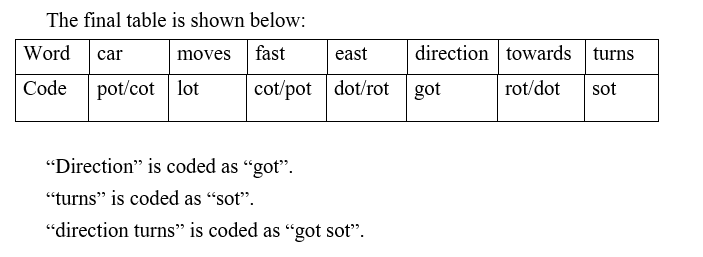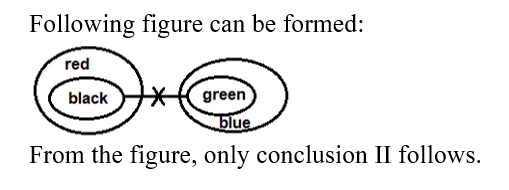Question 1:
Directions: Study the following arrangement carefully and answer the questions.
निर्देश: निम्नलिखित व्यवस्था का ध्यानपूर्वक अध्ययन करें और प्रश्नों के उत्तर दें।
H 8 % E # 3 9 U B 6 @ P & F $ 1 J 4 D V * A + 7
How many numbers are there to the right of second vowel from left end
बाएं छोर से दूसरे स्वर के दाएं ओर कितनी संख्याएं हैं?
Question 2:
Directions: Study the following arrangement carefully and answer the questions.
निर्देश: निम्नलिखित व्यवस्था का ध्यानपूर्वक अध्ययन करें और प्रश्नों के उत्तर दें।
H 8 % E # 3 9 U B 6 @ P & F $ 1 J 4 D V * A + 7
How many alphabets are immediately followed by a number?
कितने अक्षर के तत्काल बाद एक संख्या है?
Question 3:
If all the digits of the number “836254753” are arranged in decreasing order, the what is the sum of 4th and 7th digits (from the left end) of the number after rearrangement?
यदि संख्या “836254753” के सभी अंकों को घटते क्रम में व्यवस्थित किया जाता है, तो दोबारा व्यवस्थित होने के बाद संख्या के चौथे और सातवें अंक (बाएं छोर से) का योग क्या है?
Question 4:
If 1 is subtracted from each prime number digit and 1 is added to the remaining digits in the number “67524673”, then how many digits will appear twice in the new number thus formed?
यदि संख्या "67524673" के प्रत्येक अभाज्य अंक में से 1 घटाया जाता है और शेष अंकों में 1 जोड़ा जाता है, तो इस प्रकार बनी नई संख्या में कितने अंक दो बार आएंगे?
Question 5:
Directions: Answer the questions based on the information given below:
निर्देश: दिए गए जानकारी के आधार पर सवालों के उत्तर दें|
Six persons M, N, R, S, T and V have different number of coins. M has more coins than S. Only V has fewer coins than R. N doesn’t have fewer coins than T. M has fewer coins than T.
छह व्यक्ति M, N, R, S, T और V के पास सिक्कों की अलग-अलग संख्या है|M के पास S से अधिक सिक्के हैं|केवल V के पास R से कम सिक्के हैं|N के पास T से कम सिक्के नहीं है|M के पास T से कम सिक्के हैं|
If M and S have 23 and 20 coins in any order, what is the probable number of coins with V?
यदि M और S के पास 23 और 20 सिक्के हैं, किसी भी क्रम में, तो V के सिक्कों की संभावित संख्या कितनी हो सकती है?
Question 6:
Directions: Answer the questions based on the information given below:
निर्देश: दिए गए जानकारी के आधार पर सवालों के उत्तर दें|
Six persons M, N, R, S, T and V have different number of coins. M has more coins than S. Only V has fewer coins than R. N doesn’t have fewer coins than T. M has fewer coins than T.
छह व्यक्ति M, N, R, S, T और V के पास सिक्कों की अलग-अलग संख्या है|M के पास S से अधिक सिक्के हैं|केवल V के पास R से कम सिक्के हैं|N के पास T से कम सिक्के नहीं है|M के पास T से कम सिक्के हैं|
____ persons have more coins than S.
______ व्यक्ति के पास S से सिक्के अधिक है|
Question 7:
Directions: Answer the questions based on the information given below.
निर्देश: दिए गए जानकारी के आधार पर सवालों के उत्तर दें|
In a certain language,
एक कूट भाषा में,
I. ‘car moves fast’ is coded as ‘lot, pot, cot’
I. ‘car moves fast’ का कूट है ‘lot, pot, cot’
II. ‘moves towards east’ is coded as ‘dot, rot, lot’
II. ‘moves towards east’ का कूट है ‘dot, rot, lot’
III. ‘fast car turns’ is coded as ‘sot, cot, pot’
III. ‘fast car turns’ का कूट है ‘sot, cot, pot’
IV. ‘towards east direction’ is coded as ‘got, rot, dot’
IV. ‘towards east direction’ का कूट है ‘got, rot, dot’
Which of the following is the code for “moves” in the given language?
दिए गए भाषा में "moves" का कूट क्या है?
Question 8:
Directions: Answer the questions based on the information given below.
निर्देश: दिए गए जानकारी के आधार पर सवालों के उत्तर दें|
In a certain language,
एक कूट भाषा में,
I. ‘car moves fast’ is coded as ‘lot, pot, cot’
I. ‘car moves fast’ का कूट है ‘lot, pot, cot’
II. ‘moves towards east’ is coded as ‘dot, rot, lot’
II. ‘moves towards east’ का कूट है ‘dot, rot, lot’
III. ‘fast car turns’ is coded as ‘sot, cot, pot’
III. ‘fast car turns’ का कूट है ‘sot, cot, pot’
IV. ‘towards east direction’ is coded as ‘got, rot, dot’
IV. ‘towards east direction’ का कूट है ‘got, rot, dot’
___ is coded as “rot” in the given language.
दिए गए भाषा में _____ का कूट "rot" है|
Question 9:
Directions: Answer the questions based on the information given below.
निर्देश: दिए गए जानकारी के आधार पर सवालों के उत्तर दें|
In a certain language,
एक कूट भाषा में,
I. ‘car moves fast’ is coded as ‘lot, pot, cot’
I. ‘car moves fast’ का कूट है ‘lot, pot, cot’
II. ‘moves towards east’ is coded as ‘dot, rot, lot’
II. ‘moves towards east’ का कूट है ‘dot, rot, lot’
III. ‘fast car turns’ is coded as ‘sot, cot, pot’
III. ‘fast car turns’ का कूट है ‘sot, cot, pot’
IV. ‘towards east direction’ is coded as ‘got, rot, dot’
IV. ‘towards east direction’ का कूट है ‘got, rot, dot’
How is “direction turns” coded in the given language?
दिए गए भाषा में “direction turns” का कूट क्या है?
Question 10:
Direction: In the question below there are three statements followed by two conclusions I and II. You have to take the three given statements to be true even if they seem to be at variance from commonly known facts and then decide which of the given conclusions logically follows from the three statements disregarding commonly known facts.
निर्देश: प्रश्न में, तीन कथन और उसके बाद दो निष्कर्ष I और II दिए गए हैं। आपको दिए गए तीन कथनों को सत्य मानना है, भले ही वे सामान्य रूप से ज्ञात तथ्यों से भिन्न दिखाई देते हों और फिर तय करें कि दिए गए निष्कर्षों में से कौन-सा निष्कर्ष सामान्य रूप से ज्ञात तथ्यों की अवहेलना करते हुए तीन कथनों का तार्किक रूप से अनुसरण करता है।
Statements:
कथन: कोई काला हरा नहीं है / No black is green
सभी हरा नीला है / All green is blue
प्रत्येक काला लाल है / Every black is red
Conclusions:
I. कुछ लाल नीला है / Some red is blue
II. कुछ नीला काला नहीं है / Some blue is not black
(A) Neither conclusion I nor conclusion II follows
(A) न तो निष्कर्ष I और न ही निष्कर्ष II अनुसरण करता है
(B) Only conclusion I follows
(B) केवल निष्कर्ष I अनुसरण करता है
(C) Only conclusion II follows
(C) केवल निष्कर्ष II अनुसरण करता है
(D) Both conclusion I and conclusion II follow.
(D) निष्कर्ष I और निष्कर्ष II दोनों अनुसरण करते हैं।
(E) None of the above
(E) उपर्युक्त कोई नहीं




